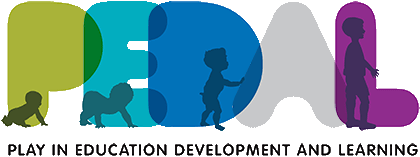Here we talk you through some of the ways we can support the social and emotional learning of babies and young children.
To find out more, you can join Coping with Changes: Social-Emotional Learning Through Play, a free online course developed by the LEGO Foundation.
The course includes more information from us (Tilly Kirby, Dr Elizabeth Byrne, and Professor Paul Ramchandani) focusing on early childhood (age 0-3 years), as well as content developed by other research teams on the development of older children, teenagers, and adults.
What is Social Emotional Learning (SEL) and when does it start?
When we talk about social and emotional development, we’re thinking about the impressive range of skills that children put to use when interacting with others. Things like sharing eye contact, talking to each other, and playing together. Expressing and identifying their own feelings, and recognising the feelings of others, are also important skills to learn for interactions in early childhood. We call the development of these skills Social Emotional Learning or SEL for short. SEL begins right at the start of life, and the positive moments that babies share with their closest caregivers provide the first layer of bricks to form a solid foundation of skills that children will use as they interact with the world around them.
What does SEL look like in early childhood?
Here are some of the key social and emotional skills that your little ones develop in their first few years:
- Attachments and early relationships: Babies start forming relationships, or attachments, with their closest caregivers from the moment they’re born! These bonds grow strong when caregivers notice and respond to the ‘signals’ that their babies send them. These signals can sometimes seem quite subtle, but simple things like following your baby’s gaze and responding to their cries lets your child know that you’re a reliable source of comfort and support who will keep them safe.
Practise: Pay attention to what your baby might be trying to tell you: babies let us know what they’re thinking or feeling in lots of ways, like through eye contact, smiling, crying, pointing, or kicking their legs. When you respond to their signals, you’re letting them know how much you care about them.
- Communication: Babies love to engage in simple back-and-forth interactions with you. Watch as they use sounds, facial expressions, and their whole bodies, to babble, coo, smile, and kick away when interacting with you. These simple interactions are babies’ first conversations, and they provide lots of great opportunities for SEL.
Practise: Listen to your baby’s babbles and coos, watch their expressions, and movements and respond. Take turns waving your hands or wiggling your fingers at each other. Do they wait for you to reply before they respond? With toddlers, you can label objects and talk about what you’re both doing as you play to help them learn new words.
- Expressing and reading emotions: Babies show us a wide range of emotions right from birth. They express feelings like interest, happiness, distress, or frustration, to let us know what they want or need. As they grow, young children learn lots about how to express their feelings, including how to manage, or regulate, them. During this time, they practice expressing themselves as they try out different ways to let you know that they’re happy, excited, upset, or frustrated. They’ll also start noticing the feelings of those around them as they connect the dots between inside and outside emotions.
Practise: Show and talk about how you feel around your child. Encourage them to talk about their feelings too and have a think together about the different ways that they can show you these feelings.
- Social and playful interactions: Babies love seeing and listening to familiar people, and enjoy interacting together through smiles, singing, and simple games like peek-a-boo. As a child grows, they start playing and interacting with other children. At first, they engage in parallel play, where they play next to and watch each other but don’t interact much. Next, they join in simple social play, this is when they learn about taking turns and sharing. As they get even older, this develops into cooperative play, where children work together towards a common goal, like building a tower or acting out their favourite characters during role play.
Practise: Watch how engaged your baby is when you reappear in a game of peek-a- boo! As they get older, see how they start to take the lead in these moments, maybe by using blankets and toys to hide behind and then surprising you by reappearing!
Why is SEL important for young children?
Early playful and responsive interactions that encourage SEL prepare children for making friends and doing well in school.
SEL also helps babies and young children cope with changes and stress. All children face stress sometimes (things like falling over and cutting their knee or getting an injection). Although these moments can be upsetting, a little bit of stress in the early years can help them learn how to cope with everyday challenges and process their feelings. Unfortunately, some children experience more long-term stress or adversity, which can make them feel vulnerable and anxious. But having loving, responsive, and consistent care and support from a caregiver helps them deal with change and stressful experiences.
Top tips for promoting early SEL:
It’s important to remember that you’re already doing lots to support your child’s social and emotional development in the everyday playful interactions that you have with them, but here are a few tips for supporting early SEL:
- Pay close attention during those back-and-forth interactions with your child: have a go at noticing and responding to the different ‘signals’ your little one is giving you. Use different gestures, facial expressions, and sounds to keep these simple conversations fun and exciting!
- Label and talk about different objects, actions, and feelings during play – this can help children to learn new words, ways to communicate, and about different emotions.
- Set a challenge, like building a tall tower or sorting shapes. As you play together, your child will learn about sharing and taking turns.

Course info
You can find out more about the Coping with Changes: Social-Emotional Learning Through Play course by clicking this link.

